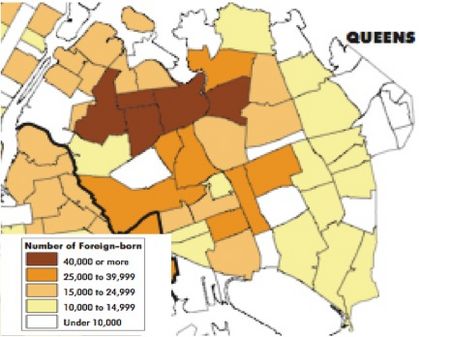From Queens: The Brand Residents Don't Buy
History
Queens: In the time of colonial America, Queens started off as an undeveloped, sparsely populated, rural area. Today, Queens is a very developed borough with immigrants from many countries and cultures flooding in to live here. In fact, when the municipal government, the media, and private companies market Queens to tourists and urbanites in other boroughs, its polyethnic existence is heavily emphasized to try and draw interest to the area.
New immigration, which refers to immigrants who moved Queens after 1965 (Foner 1), is essential to the economy of Queens, a borough known for its diversity more so than any other part of the city. New immigrants account for the majority of Queens' workforce, as well as its population. Here are a few charts that show the diversity within Queens, starting with a quick count of the total population within Queens.
From 1990 to 2000, Queens has continuously been receiving immigrants. Almost 50% of Queens is foreign-born, an important detail which again reaffirms the fact that Queens is multi-cultural and diverse. Now to see which specific cultures and countries the foreign-born in Queens belong to.
In this chart, the details of foreign-born residents in Queens are made clear. Approximately 25% of the immigrants are from Latin America and Central America who reside mainly in Corona, Elmhurst, Jackson Heights, Jamaica, and have a growing community in The Rockaways. Meanwhile, the Chinese immigrants, who make up 10% of immigrants in Queens, find a home in Flushing. The other 65% represents a conglomerate of European immigrants, African immigrants, and other groups. These immigrants reside in Jamaica, Rego Park, and Howard Beach.
So far we've seen numbers and figures, pie-charts and graphs of immigrants and foreign-born in New York City and Queens. But what does this all mean? How would this look in a real-life map of Queens- how would the population be laid out? A look at this next chart clears that up.
This last chart lays out the population of the immigrants in Queens and where most of these immigrants are situated. Proximity to the workplace greatly influences where immigrants reside in the borough. Because Manhattan contains many low income jobs due to its tourist based economy, the majority of immigrants reside in the northwest corner of Queens. Many immigrants do not speak fluent English, or their degrees are not recognized in the US, and so they take low income jobs in the tourist industry to earn a living.
As you go further east and south, away from Manhattan, Brooklyn, and the Bronx, the numbers of foreign-born decrease since they are further away from the other boroughs, and transportation is more difficult and time-consuming. On average, an immigrant's salary is very low and they are unable to afford a car to drive to work and necessary shopping. Therefore, it's natural for them to live closer to the city and other areas that offer the goods and services they need for their daily life, along the routes of public transportation.
NYC: After looking at immigration in Queens, and seeing its effect on the borough, let's take a general look at immigration in the whole of NYC. To get a better idea of where these immigrants live and are situated, here are some graphs and diagrams that illustrate certain points.
As can be seen from the map, Queens has the second highest population of all the boroughs in the city. This is not only because Queens is larger in area than the other boroughs, but also because it is conveniently located near three other boroughs as well- Brooklyn, Bronx, and Manhattan, so immigrants and other residents living in Queens can easily travel from one borough to another. Also, as you will find in later pages, Queens was historically a hub for immigrants (once the subway system was opened in 1904), from both the first wave of immigration in the mid-1800s and the new wave of immigration post 1965 (Foner 38).
Gradually, through the mid 19th and early 20th century, the rate of foreign-born people has been rising just as the rate of the native-born has, reflecting the great waves of immigration into the country. Although the rate of native-born New Yorkers far out-numbers that of the foreign-born, the percentages show that it is still quite high and ever-increasing, as foreign-born immigrants continuously immigrate into the United States. But where do these foreign-born immigrants come from?
This chart shows the overall general percentage of immigrants that come from each continent, without going into the specifics such as certain cities and places. The highest percentage of foreign-born residents comes from Latin America, followed by Asia, the Caribbean, and Europe, to make up more than 95% of all immigrants in the city. Now, where do all these foreign-born immigrants choose to stay in New York City?
In this chart, Queens and Brooklyn dominate as the two places with the highest percentage of foreign-born residents and where most immigrants are likely to move to upon arriving in New York. Both boroughs are situated close to Manhattan, but offer more affordable housing than the city.
Sources:
Foner, Nancy. From Ellis Island to JFK. New Haven: Yale University Press, 2000. Print.
New York City Department of Planning. N.p., n.d. Web. 4 April 2010. <http://www.nyc.gov/html/dcp/>.
For the history of different neighborhoods in Queens, please click next. To skip to the next topic, click on How is Queens Branded?







